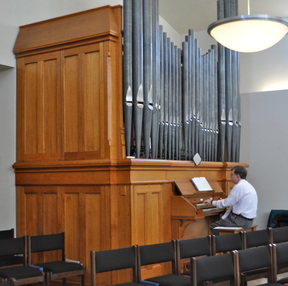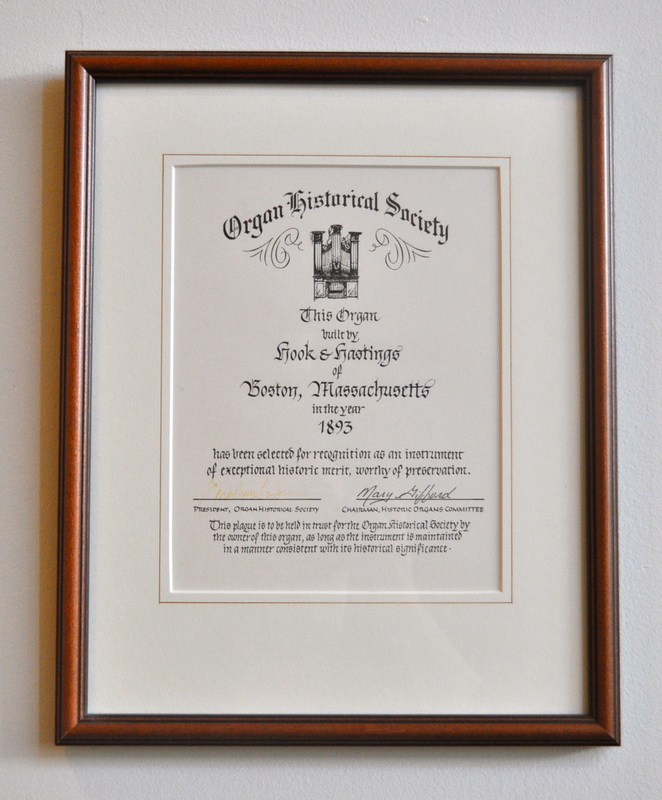Our Organ

HISTORY
The organ at Covenant was originally built by the Hook & Hastings organ company of Boston for the First Baptist Church in Georgetown, Kentucky, in 1893. The Hook & Hastings company was begun in 1827 by the brothers Elias and George Hook. The company grew steadily into the foremost American organ building firm of the 19th century, building the largest instruments of their time, incorporating the latest European innovations, and earning a reputation for the most refined and exciting tonal qualities while also maintaining by far the highest level of production of any company in the United States. In 1855, Francis Hastings began work at the firm as a draftsman, rising eventually to become partner in 1872. He inaugurated advertising programs and the design and promotion of stock-model organs, produced in quantity according to set specifications, to develop the market for smaller church organs, while maintaining the company's command of custom-built larger instruments. The organ at Covenant is basically one of these stock models, matching the description of Size No. 36 as described in a brochure dated 1881. The organ was restored and rebuilt by Bradley Rule. A graduate of the University of Tennessee at Knoxville, with a major in organ performance, he worked as an apprentice and then supervisor of old organ restorations at Andover Organ Company in Lawrence, Massachusetts, from 1982 to 1988. He then started his own company in New Market, Tennessee, and has restored and rebuilt a number of old tracker organs in Tennessee, Kentucky, Alabama, and Massachusetts. During 1999, while our church building was being designed, we located and purchased this 2-9 Hook & Hastings Pipe Organ. See our organ's listing in the Pipe Organ Database.
|
How it Works
The organ at Covenant has tracker action: that is, the connection between the keys and the valves which admit air to the pipes is a direct mechanical linkage. This permits the organist to have direct control over the speed at which these valves are opened, and thus to have a greater range of expression in articulation, or the attack and release of the notes. In addition, the manual windchests are slider chests. These have the advantage that all the pipes for each note share the same wind channel and are activated by a shared valve. This contributes to greater cohesiveness and blend of the chorus of stops. The organ has nine ranks or sets of pipes. Each rank has one pipe per note on the keyboard or pedalboard. There are a total of 479 pipes. The four ranks played from the lower of the two manual keyboards, the Great division, stand just behind the case facade pipes. The largest pipes of the Open Diapason and Octave stops are placed in the case facade. The four ranks played from the upper Keyboard, or Swell division, are located behind the Great and are enclosed in a swell box. It has an opening composed of vertical swell shades which can be opened or closed sing the balanced swell pedal located to the right of the pedalboard, thus permitting a form of volume control. The pedal Bourdon pipes are located to the right and left of the Great and Swell divisions. The Restoration The restoration of the organ at Covenant involved the planning and repairing of manual and pedal chests, releathering the reservoir and hand pumped bellows, renovation of all mechanical action parts, recovering the keyboards, repair and regulation of all pipes, and stripping and restoration of the organ case, which is of quarter sawn oak. Covenant members sanded and refinished the case. There were two modifications to the organ. The Great Dulciana stop was replaced by a 2' Principal to expand the Great principal chorus. The Swell Oboe, originally starting at Tenor C, was expanded one octave lower to be full compass, the bass octave being built to the same scale and measurements of Hook & Hastings Oboe pipes of that period. The restoration of the Hook & Hastings organ at Covenant has preserved an historic "speaking monument" for future generations. However, this old instrument also embodies the principles of the modern organ reform movement: mechanical action, classic voicing on low wind pressure, and enclosure of the pipes in a free standing resonant case. Most important, it is an instrument that supports a wide range of church music, from solo organ literature, to versatile choral music accompaniment, and strong foundation for congregational singing, giving an added dimension to the corporate worship experience. Restored and Rebuilt, B. Rule & Co., New Market, Tennessee • 2 manuals and pedal • manual compass - 58 notes • pedal compass - 27 notes • mechanical (tracker) key action, mechanical stop action • 479 pipes • Great • 8' Open Diapason (lower 18 pipes in case), zinc, common metal • 8' Melodia, open wood • 4' Octave (lower 5 pipes in case), zinc, common metal • 2' Fifteenth, spotted metal • Swell( enclosed) • 8' Stopped Diapason, stopped wood • 8' Viola (from Tenor C), zinc, common metal • 4' Flute (harmonic from middle C), zinc, common metal • 8' Oboe, zinc, spotted metal • Pedal • 6' Bourdon, stopped wood • Couplers • Swell to Great 8' • Swell to Great 4' • Great to Pedal • Swell to Pedal • Mechanical Swell action, balanced pedal • Tremolo • Bellows Signal • Hand pump/feeder bellows Written by Carl McAliley, Covenant Church Organist, March 5, 2000 |

